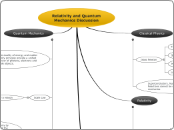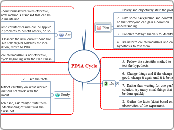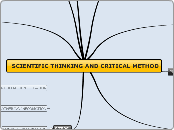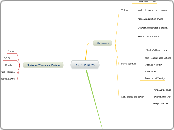Relativity and Quantum Mechanics Discussion
Quantum Mechanics
Copenhagen Interpretation
There is no quantum reality. We can only theorize on the observable, so quantum theory can never take into account the metaphysical. Only the observable reality
The other theory presented by Einstein says that probabilities show our inability to describe quantum mechanics. But it is pointless to say that it does not exist alltogether. We study what we can describe and observe
One theory says that this means the universe is indeterministic
This is why we use probabilities
quantum mechanics does not yield an objective description of microscopic reality but deals only with probabilities, and that measurement plays an ineradicable role
Observation can throw off experiments
When you look at something, the photon exchange from your eyes to the object can alter the results. We are talking SMALL here. VERY SMALL
Schrödinger
Wave Function
Heisenberg's Uncertainty Principle
Double-Slit Difraction
Observation?
When the experiment is observed/measured the particles act as classical physics would describe.
Photons are fired at a sheet with two slits in it
Once fired, they should produce two lines on the screen behind it, right?
Wrong. They produce a wave interference pattern
the double-slit experiment demonstrates the inseparability of the wave and particle natures of light and other quantum particles
Schrodinger's Cat
Modern Physics Induces Skepeticism
A cat, along with a flask containing a poison and a radioactive source, is placed in a sealed box shielded against environmentally induced quantum decoherence. If an internal Geiger counter detects radiation, the flask is shattered, releasing the poison that kills the cat. The Copenhagen interpretation of quantum mechanics implies that after a while, the cat is simultaneously alive and dead. Yet, when we look in the box, we see the cat either alive or dead, not both alive and dead.
One cannot know both the position and momentum of a particle simultaneously
describes the probability amplitude of the position and momentum of a particle.
Max Planck
Black Body Radiation
Spectral Analysis
Color Patterns
some physical quantities can be changed only by discrete amounts, or quanta, as multiples of the Planck constant, rather than being capable of varying continuously or by any arbitrary amount
Scale Law
Objects are a particular size for a reason
Quantum realm particles are bizzare because they are VERY small
Human bones are proportional to distribute the weight
Beached Whales die because they are crushed by their own weight
the wave–particle duality of energy and matter and the uncertainty principle provide a unified view of the behavior of photons, electrons and other atomic-scale objects.
Richard Feynman
Nobody really understands quantum theory
Fundamentally, it attempts to explain the peculiar behaviour of matter and energy at the subatomic level—an attempt which has produced more accurate results than classical physics in predicting how individual particles behave.
Where to Next?
String theory
Relativity
General Relativity
Theory of Gravitation
The Universe is expanding, and the far parts of it are moving away from us faster than the speed of light.
Balloon Analogy
Rotating masses "drag along" the spacetime around them; a phenomenon termed "frame-dragging".
Rays of light bend in the presence of a gravitational field.
Clocks run more slowly in regions of lower gravitational potential. This is called gravitational time dilation.
Special Relativity
Moving clocks are measured to tick more slowly than an observer's "stationary" clock.
Measurement
Objects are measured to be shortened in the direction that they are moving with respect to the observer.
Mass-Energy Equivalence
E=mc^2
Speed
We cannot travel faster than the speed of light. At that point our mass essentially becomes energy. We would then exhibit wave-particle properties
Simultaneity
Two events, simultaneous for one observer, may not be simultaneous for another observer if the observers are in relative motion.
Train Paradox in More Detail
Special relativity is based on two postulates which are contradictory in classical mechanics:
The speed of light in a vacuum is the same for all observers, regardless of their relative motion or of the motion of the source of the light.
The laws of physics are the same for all observers in uniform motion relative to one another (principle of relativity),
Classical Physics
Superconductors, Nuclear and Chemical Reactions cannot be explained using classical mechanics
Isaac Newton
Light
Matter
Space
Time









